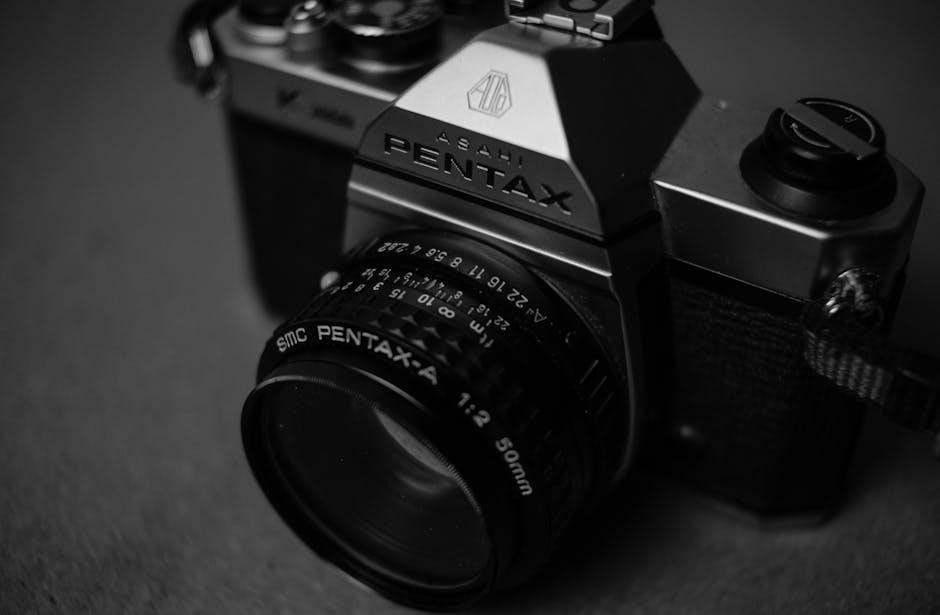This manual provides a comprehensive guide for installing‚ configuring‚ and operating the Honeywell DC2500 controller‚ ensuring optimal performance and troubleshooting in industrial environments.
1.1 Overview of the Honeywell DC2500 Controller
The Honeywell DC2500 is a universal digital controller designed for precise control of temperature and other industrial processes. It features advanced PID tuning‚ programmable functions‚ and customizable profiles‚ making it suitable for applications like environmental chambers‚ furnaces‚ and packaging machinery. With Ethernet/Modbus communication and fast scanning capabilities‚ it ensures efficient monitoring and control. The controller is user-friendly‚ offering a quick start guide and comprehensive manual for easy setup and troubleshooting. Its robust design and versatility make it a reliable choice for industrial automation‚ providing accurate and consistent performance in demanding environments.
1.2 Importance of the User Manual for Effective Operation
The user manual is essential for understanding and utilizing the Honeywell DC2500 controller effectively. It provides detailed instructions for installation‚ configuration‚ and operation‚ ensuring users can harness the controller’s full potential. The manual also offers troubleshooting guidelines and explanations of advanced features‚ enabling users to resolve issues quickly and optimize performance. By following the manual‚ users can avoid common pitfalls and ensure safe‚ efficient operation; It serves as a reliable reference‚ empowering users to maintain and troubleshoot the controller confidently. The manual’s comprehensive guidance is crucial for maximizing the controller’s functionality and longevity in industrial environments.

Installation of the Honeywell DC2500 Controller
This section provides a comprehensive guide to installing the Honeywell DC2500 controller‚ including system requirements‚ step-by-step instructions‚ and connecting inputs and outputs for smooth setup.
2.1 System Requirements and Compatibility
The Honeywell DC2500 controller is designed to operate in various industrial environments‚ requiring specific system and compatibility standards. It supports universal inputs‚ including temperature‚ pressure‚ and flow measurements‚ ensuring versatility. The controller is compatible with Ethernet and Modbus communication protocols‚ enabling seamless integration with industrial networks. For optimal performance‚ it requires a power supply of 24V DC‚ with a current rating sufficient for connected devices. Environmental operating conditions include a temperature range of 0°C to 55°C and humidity levels up to 80% non-condensing. Compatibility with Honeywell software tools ensures easy configuration and monitoring. Adherence to these requirements guarantees reliable operation and integration into existing industrial systems.
2.2 Step-by-Step Installation Guide
Begin by ensuring the system meets the specified requirements. Mount the Honeywell DC2500 controller on a flat surface using the provided brackets‚ ensuring good ventilation. Connect the power supply‚ adhering to the 24V DC requirement‚ and secure all wiring according to the terminal layout. Connect input and output devices‚ verifying compatibility with the controller’s universal inputs. Power on the device and perform a self-test to ensure proper operation. Configure communication settings if network integration is required. Finally‚ test all connected systems to confirm functionality. Follow the manual for detailed wiring diagrams and safety precautions to ensure a safe and efficient installation process.
2.3 Connecting Inputs and Outputs
Connect the Honeywell DC2500 controller by first identifying the input/output terminals. Universal inputs support various signal types‚ while digital inputs are for binary signals. Outputs include relays and SSRs for controlling external devices. Wire each terminal securely‚ ensuring compatibility and load specifications are met. Test all connections post-installation to confirm functionality and safety. Always follow safety guidelines when handling electrical components.

Configuration of the Honeywell DC2500 Controller
Configure the DC2500 by setting up inputs‚ outputs‚ and PID parameters. Adjust communication settings for network integration and enable advanced features like automated tasks and data logging.
3.1 Initial Setup and Configuration
Start by powering up the Honeywell DC2500 and navigating to the main menu. Select the setup option to initialize the controller. Choose the language and unit preferences. Enter the IP address for network connectivity if required. Set the date and time to ensure accurate data logging. Configure the input types‚ such as temperature or pressure sensors‚ according to your application. Define output settings to match your system’s requirements. Save all changes to complete the initial setup. This process ensures the controller is ready for advanced configuration and operation‚ providing a smooth transition to more complex tasks.
3.2 Configuring Inputs and Outputs

Configure inputs by selecting the appropriate sensor type‚ such as thermocouple or RTD‚ and set the scaling factors. Ensure the input channels are correctly mapped to their respective variables. For outputs‚ specify the control type‚ like PID or ON/OFF‚ and set the alarm limits. Assign each output to a specific input channel for precise control. Adjust the output ranges to match your system’s requirements. Enable communication protocols if using Ethernet or Modbus for integration with other devices. Save all configurations to apply the settings. Proper configuration of inputs and outputs ensures accurate monitoring and control‚ optimizing the performance of your Honeywell DC2500 controller in various industrial applications.
3.3 PID Tuning and Advanced Configuration Options
PID tuning allows precise control of your system by adjusting proportional‚ integral‚ and derivative settings. Access the PID parameters through the control panel or software interface. Start with default values and gradually fine-tune based on system response. Enable adaptive tuning for automatic adjustments. Advanced features include feedforward control for anticipating disturbances and cascade control for multi-loop systems. Configure these settings to enhance stability and reduce error margins. Use the manual to guide you through complex configurations. Proper PID tuning and advanced settings optimization are critical for achieving optimal performance in industrial applications‚ ensuring accurate and reliable control of your processes.
3.4 Communication Settings and Network Integration
Configure communication settings to enable network integration of the Honeywell DC2500 controller. Select from various protocols such as Modbus TCP/IP and Ethernet for seamless connectivity. Assign IP addresses and ports to ensure proper data transmission. Use the built-in web server to remotely monitor and control the controller. Integrate with SCADA systems for centralized management. Set up baud rates and data formats to match your network requirements. Enable encryption and secure authentication for data protection. Troubleshoot communication issues using diagnostic tools. Proper configuration ensures reliable data exchange‚ enhancing system performance and enabling remote monitoring and control in industrial environments.

Operation of the Honeywell DC2500 Controller
6.4 Integration with Other Honeywell Products
The Honeywell DC2500 integrates seamlessly with other Honeywell systems‚ enhancing functionality and control. Compatible with Honeywell thermostats and industrial sensors‚ it ensures unified monitoring and optimal performance.
4.1 Basic Operation Overview
The Honeywell DC2500 controller operates by monitoring and controlling process variables such as temperature‚ ensuring precise regulation. Users can navigate the intuitive interface to set parameters‚ view real-time data‚ and adjust settings. The controller supports various input types and provides accurate control through advanced algorithms. Basic operation involves powering up the device‚ configuring inputs‚ and enabling control modes. The system also allows for manual overrides and alarms to maintain operational safety. With its user-friendly design‚ the DC2500 simplifies process control‚ making it accessible for both novice and experienced operators. Regular updates and maintenance ensure reliable performance in industrial environments.
4.2 Navigating the User Interface
The Honeywell DC2500 features an intuitive user interface designed for ease of navigation. The menu structure is organized into logical categories‚ allowing users to access configuration‚ monitoring‚ and control functions effortlessly. The display provides clear visual feedback‚ including real-time process variables‚ alarm statuses‚ and menu options. Navigation buttons enable quick movement between screens‚ while soft keys offer context-sensitive commands. Users can customize the interface by setting favorites or adjusting display parameters. The interface supports multiple languages and is compatible with both novice and advanced operators. This design ensures efficient operation‚ minimizing learning curves and enhancing productivity in industrial environments.
4.3 Monitoring and Controlling Variables
The Honeywell DC2500 allows precise monitoring and control of process variables such as temperature‚ pressure‚ and flow rates. Real-time data is displayed on the interface‚ enabling users to track changes and adjust settings as needed; The controller features graphical trending to visualize historical data‚ aiding in process optimization. Alarms can be set for variable deviations‚ ensuring timely interventions. Users can modify setpoints‚ output levels‚ and control strategies directly through the interface. Input and output configurations are easily accessible‚ allowing for accurate sensor calibration and actuator control. This functionality ensures seamless monitoring and control‚ making the DC2500 a reliable tool for maintaining operational consistency in industrial environments.
4.4 Using Advanced Features for Optimal Performance
The Honeywell DC2500 offers advanced features to enhance operational efficiency. Users can leverage PID tuning to optimize control loops‚ ensuring precise regulation of variables like temperature and pressure. Automated tasks and scheduling enable hands-free operation‚ reducing the need for manual intervention. Data logging capabilities allow for detailed performance analysis‚ while communication settings facilitate integration with other systems. Customizable profiles and programmable functions enable tailored solutions for specific applications. The controller also supports real-time adjustments‚ ensuring adaptability to changing conditions. By utilizing these features‚ users can maximize productivity‚ reduce errors‚ and achieve consistent results in industrial environments. The user manual provides detailed guidance for accessing and configuring these advanced tools effectively.

Troubleshooting the Honeywell DC2500 Controller
Identify common issues‚ error codes‚ and solutions. Use diagnostic tools for quick resolution. Perform regular maintenance to prevent malfunctions and ensure smooth operation of the controller.
5.1 Common Issues and Solutions
Common issues with the Honeywell DC2500 include communication errors‚ sensor malfunctions‚ and display problems. Error codes like “E01” indicate communication faults‚ while “E02” suggests sensor issues. Solutions involve checking connections‚ restarting the controller‚ or recalibrating sensors. For display problems‚ ensure proper power supply and firmware updates. Refer to the troubleshooting section for detailed solutions and diagnostic tools to resolve issues quickly and efficiently‚ minimizing downtime and ensuring optimal performance. Regular maintenance and software updates can prevent many of these issues. Always consult the manual for specific error code meanings and step-by-step repair guidance.
5.2 Error Codes and Their Meanings
The Honeywell DC2500 displays error codes to indicate specific issues. “E01” typically signifies a communication fault‚ while “E02” points to sensor or input problems. “E03” may indicate overheating or output failures. Each code corresponds to a detailed explanation in the manual‚ guiding users through diagnostic steps. For example‚ “E01” suggests checking network connections or restarting the controller. “E02” may require recalibrating sensors or replacing faulty ones. Understanding these codes helps resolve issues efficiently‚ ensuring minimal downtime. Refer to the troubleshooting section for a complete list of codes and solutions to maintain optimal controller performance and address problems promptly. Regular updates and maintenance can prevent many of these errors.
5.3 Diagnostic Tools and Techniques
The Honeywell DC2500 offers advanced diagnostic tools to identify and resolve issues efficiently. The built-in diagnostic menu provides real-time data on system performance‚ allowing users to monitor inputs‚ outputs‚ and communication status. Utilize the controller’s logging feature to track historical data and pinpoint trends or recurring faults. Additionally‚ the manual recommends using external tools like Honeywell’s proprietary software for deeper analysis. Regular system checks and firmware updates ensure optimal functionality. By leveraging these tools‚ users can proactively address potential problems‚ minimize downtime‚ and maintain precise control over their processes. These techniques are essential for troubleshooting and ensuring the controller operates at peak performance levels consistently.
5.4 Best Practices for Maintenance and Repair
Regular maintenance is crucial to ensure the Honeywell DC2500 controller operates efficiently and reliably. Start by cleaning the unit with approved materials to prevent dust buildup. Schedule periodic inspections of all connections and wiring to avoid loose or corroded contacts. Update firmware and software promptly to benefit from performance improvements and bug fixes. When repairing‚ always refer to the official manual or contact Honeywell support for genuine parts and guidance. Keep a backup of configuration settings before performing any repairs. Use diagnostic tools to identify issues early and address them proactively. Following these practices extends the controller’s lifespan‚ minimizes downtime‚ and ensures consistent performance in industrial environments; Proper maintenance also enhances safety and operational accuracy. By adhering to these guidelines‚ users can maintain optimal functionality and reliability of the Honeywell DC2500 controller.

Advanced Features of the Honeywell DC2500 Controller
The Honeywell DC2500 offers programmable functions‚ automated tasks‚ and data logging for enhanced customization and efficiency in industrial control applications‚ ensuring precise and reliable operations.
6.1 Programmable Functions and Customization
The Honeywell DC2500 controller offers extensive programmable functions‚ allowing users to customize inputs‚ outputs‚ and control algorithms to suit specific applications. Advanced customization options enable tailored configurations for precise control‚ enhancing operational efficiency. The controller supports programmable profiles‚ enabling users to define unique settings for different processes. Additionally‚ it allows for custom logic implementation through user-defined programs‚ ensuring flexibility in complex industrial environments. These features empower users to adapt the controller to their specific needs‚ optimizing performance and streamlining operations. The programmable functions also include data logging and automated task scheduling‚ further enhancing the controller’s versatility and functionality in various industrial settings.
6.2 Automated Tasks and Scheduling
The Honeywell DC2500 controller supports automated tasks and scheduling‚ enabling users to set up routines for repetitive operations. This feature minimizes manual intervention‚ enhancing efficiency and consistency; Users can program specific actions‚ such as data logging‚ alarm notifications‚ and process adjustments‚ to occur at predefined intervals. The controller also allows for event-based scheduling‚ triggering tasks in response to system conditions. Automated tasks ensure precise control and reduce the likelihood of human error. With real-time monitoring and customizable schedules‚ users can optimize their workflows and maintain peak performance. This functionality is particularly useful in industrial applications where predictable and reliable operation is crucial.
6.3 Data Logging and Analysis
The Honeywell DC2500 controller offers robust data logging capabilities‚ enabling users to capture and store critical process data for detailed analysis. The controller can record temperature‚ pressure‚ and other variable trends over time‚ providing insights into system performance. Data is stored internally or exported via Ethernet or Modbus communication for further analysis. Advanced software tools allow users to visualize trends‚ identify patterns‚ and optimize processes. Customizable logging intervals and triggers ensure precise data capture. This feature is essential for troubleshooting‚ quality control‚ and compliance reporting. By leveraging data logging‚ users can make informed decisions to enhance efficiency and maintain optimal operational conditions. The DC2500’s data analysis tools empower users to unlock actionable insights from their process data.
The Honeywell DC2500 controller seamlessly integrates with other Honeywell products‚ enhancing functionality and system scalability. It works alongside Honeywell’s industrial measurement and control solutions‚ including monitoring software and peripheral devices. Ethernet and Modbus communication protocols enable easy connectivity to Honeywell’s broader ecosystem. This integration allows for centralized monitoring‚ control‚ and data management across multiple devices. Users can leverage Honeywell’s comprehensive tools to streamline operations and improve efficiency. The controller’s compatibility with Honeywell’s product lineup ensures a cohesive and adaptable system‚ meeting the demands of complex industrial environments. This integration capability makes the DC2500 a versatile and reliable choice for integrated process control solutions.

Safety Precautions and Guidelines
Adhere to general safety practices‚ electrical precautions‚ and environmental guidelines to ensure safe operation of the Honeywell DC2500 controller and prevent potential hazards or system damage.
7.1 General Safety Information
Ensure safe operation by following general safety guidelines. Read the manual thoroughly before installation or use. Avoid exposing the controller to extreme temperatures‚ moisture‚ or physical stress. Keep the device away from flammable materials and ensure proper ventilation. Use only approved power sources and avoid overloading circuits. Handle electrical components with care to prevent damage or electrical shock. Follow all local safety regulations and industry standards. Regularly inspect the controller for signs of wear or damage. Do not attempt repairs without proper training or authorization. Store the device in a dry‚ secure location when not in use. Adhere to these precautions to maintain safety and system integrity.

7.2 Electrical Safety Considerations
Adhere to electrical safety practices to prevent hazards. Connect the Honeywell DC2500 Controller to a power supply that matches its rated voltage and frequency. Avoid overloading circuits‚ as this can cause malfunctions or fires. Use only approved cables and connectors to ensure proper electrical connections. Disconnect power before performing maintenance or repairs. Ground the controller correctly to prevent electrical shock. Avoid exposing the device to high-voltage spikes or surges‚ which can damage internal components. Use surge protectors if necessary. Never touch electrical components while powered on. Ensure all wiring meets local electrical codes and standards. Follow proper lockout/tagout procedures during servicing. Electrical safety is critical for reliable operation and personnel protection.
7.3 Environmental and Operating Conditions
The Honeywell DC2500 Controller is designed to operate in specific environmental conditions. Ensure the controller is used in temperatures between 0°C and 55°C (32°F to 131°F) and humidity levels below 80% RH. Avoid exposing the device to direct sunlight‚ moisture‚ or pollutants. Install the controller in a well-ventilated area to prevent overheating. The device should be mounted on a stable surface‚ free from vibration. For storage‚ keep the controller in a dry environment with temperatures between -20°C and 60°C (-4°F to 140°F). Adhere to these conditions to maintain optimal performance and extend the lifespan of the controller. Proper environmental adherence ensures reliable operation and minimizes risk of damage;

Maintenance and Upkeep of the Honeywell DC2500 Controller
Regular maintenance ensures the Honeywell DC2500 Controller operates efficiently. Clean the device‚ inspect connections‚ and update software periodically for optimal performance and extended lifespan.
8.1 Routine Maintenance Tasks
Regular maintenance is crucial to ensure the Honeywell DC2500 Controller operates efficiently. Clean the device to prevent dust buildup‚ which can affect performance. Inspect all connections and cables for damage or wear. Check for loose wires and tighten them if necessary. Update the software and firmware periodically to access new features and improvements. Refer to the user manual for specific cleaning solutions and methods to avoid damaging the controller. Additionally‚ schedule periodic checks of input and output configurations to ensure accuracy. Regularly review data logs to identify potential issues early. By following these routine tasks‚ you can maintain optimal functionality and extend the lifespan of your Honeywell DC2500 Controller.
8.2 Software Updates and Firmware Upgrades
Keeping the Honeywell DC2500 Controller up to date with the latest software and firmware is essential for optimal performance and security. Regularly check Honeywell’s official website or use the controller’s built-in update tool to verify if new versions are available. Before performing an update‚ ensure all critical operations are paused and backup your current configuration to prevent data loss. Follow the step-by-step instructions provided in the user manual or online support resources to install updates correctly. After completing the update‚ restart the controller and verify that all functions operate as expected. Updating your device ensures you benefit from the latest features‚ bug fixes‚ and enhanced compatibility.
8.3 Cleaning and Handling Precautions
Proper cleaning and handling of the Honeywell DC2500 Controller are crucial to maintain its performance and longevity. Use a soft‚ dry cloth or an antistatic brush to gently remove dust or debris from the exterior and vents. Avoid using harsh chemicals‚ liquids‚ or abrasive materials‚ as they may damage the finish or internal components. Ensure the controller is powered off before cleaning. When handling the device‚ ground yourself by touching a grounded metal object to discharge static electricity‚ which can harm sensitive electronics. Store the controller in a protective case or its original packaging when not in use to prevent physical damage. Regular maintenance ensures reliable operation and extends the lifespan of the device.
The Honeywell DC2500 User Manual offers comprehensive guidance‚ ensuring ease of setup‚ operation‚ and troubleshooting‚ making it an indispensable resource for optimal performance and efficiency.
9.1 Summary of Key Features and Benefits
The Honeywell DC2500 controller is a versatile and reliable solution for industrial applications‚ offering advanced features such as PID tuning‚ customizable profiles‚ and automated tasks. Its universal input compatibility‚ fast scanning capabilities‚ and robust communication options ensure precise control and seamless integration with other systems. The controller supports Ethernet/Modbus communication‚ enabling efficient network integration. Additionally‚ its data logging and analysis capabilities provide valuable insights for process optimization. With a user-friendly interface and comprehensive manual guidance‚ the DC2500 is designed to enhance operational efficiency and reduce downtime. Its durability and ease of maintenance make it a cost-effective choice for various industrial environments‚ ensuring long-term performance and reliability.
9.2 Final Tips for Optimal Performance
To maximize the Honeywell DC2500 controller’s performance‚ ensure regular software updates and firmware upgrades are performed. Properly configure PID settings for precise control and utilize automated tasks for efficiency. Regularly clean and maintain the device to prevent dust interference. Always follow safety guidelines and environmental operating conditions to prolong lifespan. Leverage data logging for performance insights and integrate with other Honeywell products for enhanced functionality. Refer to the user manual for troubleshooting common issues and error codes. By following these tips‚ users can optimize the controller’s capabilities‚ ensuring reliable operation and minimizing downtime in industrial applications.




